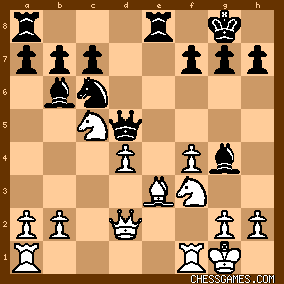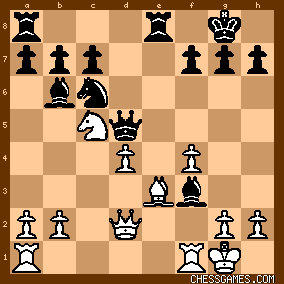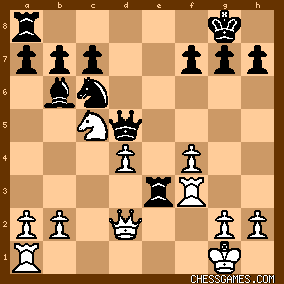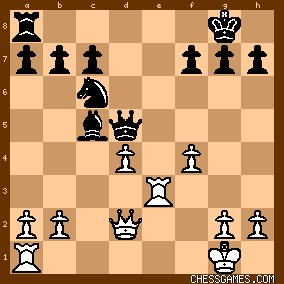|
< Earlier Kibitzing · PAGE 2 OF 2 ·
Later Kibitzing> |
| Dec-30-03 | | patzer2: Perhaps instead of 4. c3, Judit Polgar should have played the developing move 4. Nc3 recommended by Kasparov and Keene in BCO as leading to a slight White advantage. Short vs Zhu Chen, 2002 and G M Todorovic vs D Blagojevic, 2001 are two examples of successful White play with this flexible and sound developing move (4. Nc3) at this juncture. |
|
| Dec-30-03 | | patzer2: <Malacha> Fritz 8 is a commercial Chess playing and analysis program I use, with a playing strength calculated somewhere between 2700 and 2800 plus (depending on who's figuring it and how long I let it run). When evaluating a complex position, I will set up the position on Fritz 8 for deep analysis (File/New/Position Setup/(set up position)/OK). Then after setting up the position on the computer's analysis board (drag and drop), indicating whether either side has castled and setting the move number, I have Frisk 8 do a deep analysis of the position (tools/analysis/deep position analysis). The longer Frisk runs the deeper it looks at the position and generally the better its analysis gets. The depth number or ply indicates the depth of search of the computer in examining the position and the number indicates the number of thousands of positions examined in the search. So, the higher the depth number and the bigger the number of thousands of positions searched, the deeper is the computer's analysis. In some very difficult positions, I have let Fritz go as deep as 19 depth and almost one million (1,000k/Ns) positions looking for a best move. However, that takes a long time and eats up a lot of computer resources. You will see similar postings when ChessGames.Com uses <Crafty> to analyze a difficult tactical position. As a warning, Chess Programs are excellent at figuring out wins in tactical positions, but in closed positions (or positional chess in general) where there is no straight forward combination to win they can make mistakes (e.g. the recent Fritz X3D loss to Kasparov). I currently own Fritz 8 and Chess Master 9000, but rely on Fritz 8 as my analysis parter as it is much the stronger of the two programs. However, Chess Master 9000 has a much better tutorial and is more fun in my opinion for those trying to improve to the expert level. So, I recommend both of them (Fritz for analysis (and study and instruction) and Chess Master 9000 for fun and education). There is also a free on line computer analysis program at Chesslab.com, which is useful for finding games and positions but is not as strong as Fritz 8 in analysis. |
|
| Dec-30-03 | | patzer2: Forgot to mention the computer's position assessment number, as I understand it. 0.00 to 0.49 are about even =
-0.49 to 0.00 are about even =
0.50 to 0.99 slightly favor White
-0.50 to -0.99 slightly favor Black
-1.00 to -1.49 clearly favor Black
1.00 to 1.49 clearly favor White
-1.50 to -30.00 etc. and  indicates a won position for Black indicates a won position for Black 1.50 to 30.00 etc. and  indicates a won position for White. indicates a won position for White. The symbol such as #9 indicates a mate-in-9 moves. |
|
| Dec-30-03 | | Malacha: <patzer2> Thanks very much patzer for your information.I understand now.Your explaination has been very useful to me. |
|
| Dec-30-03 | | Lawrence: patzer2, is there any difference in result between the tools/analysis/deep position analysis that you mention and game/infinite analysis? |
|
| Dec-30-03 | | patzer2: <Lawrence> I haven't made much use of game/infinite analysis. Most of the time I'm interested in a specific position that strikes my fancy as I look at the score a game. So Fritz 8's tools/analysis/deep position analysis has best met my need for analysis. I have deep position analysis set to look at five alternative moves. Often when it looks like Fritz 8 has settled on a best move, I stop the analysis, make the obvious move and then have the program run again to eliminate the computer wasting time looking at weaker alternatives. Frequently, I have Fritz 8 look at alternatives I think it may have missed. More often than not Fritz will teach me a lesson in tactics I overlooked as to why my alternative is inferior to its choice. However, sometimes I can apply a little human common sense and positional feel and get Fritz 8 to come up with a better move. |
|
| Dec-31-03 | | patzer2: In the analysis at my first post above to this game, all references to 11...d4 should read 11...d5. |
|
| Dec-31-03 | | true archon: i hate to ask this, but what does black have up his sleeve after white moves 26. Rf3-e3? |
|
| Dec-31-03 | | patzer2: <true archon> Good catch! If this scoresheet is correct (and I suspect it isn't), with the possibility of playing 26. Rf3-e3! Judit Polgar's resignation was premature as White actually has a small advantage. Best play per Fritz 8 would go 26. Rfe3 axb4 27. axb4 Nxb4 28. Rxe4 Rxe4 29. Ra3 Kh7 30. kf1 b6 31. Ra7 Kg6 32. h3 f5 33. Rb7 with a slight White advantage (+1.00 @ 15/42 depth & 746kN/s). However, I find it hard to believe that a Super GM like Judit Polgar would have resigned in a superior position. Perhaps she lost on time or more likely there is a scoresheet error. This position could have been easily avoided by Black in simply avoiding the 25...a5?? blunder (e.g. 25...Qf1 or 25...Qe1+ or 25...Qc4 or 25...Qg6 or 25...Rd8) while maintaining the winning advantage (extra pawn and two pieces for the rook) previously discussed. |
|
| Aug-01-10 | | notyetagm: Judit Polgar vs M Sharif, 1989 What a *beautiful* <PETITE COMBINAISON> by Black (Sharif). 14 ... ?

click for larger view14 ... ♗g4x♘f3! <remove guard: d2,d4>

click for larger view15 ♖f1x♗f3 ♖e8x♗e3! <remove guard: d2,d4>

click for larger view16 ♖f3x♖e3! ♗b6x♘c5 <pin: d2>

click for larger viewBeautiful!
First 14 ... ♗g4x♘f3! and 15 ... ♖e8x♗e3! <DESTROY (REMOVE THE GUARD)> *both* defenders of the White d2-queen. Then 16 ... ♗b6x♘c5 exploits a <PIN AGAINST AN UNDEFENDED PIECE>, the <UNDEFENDED> White d2-queen. Why is the White d2-queen <UNDEFENDED>? Because we just <REMOVED ITS GUARD> with 14 ... ♗g4x♘f3! and 15 ... ♖e8x♗e3!. The chess coaches always tell you: <PLAY THE OPEN GAME TO LEARN TACTICS!>. This game is a *perfect* example. Strange to see Judit Polgar caught out tactically like this. |
|
| Aug-01-10 | | notyetagm: Game Collection: Why trade pieces? TO GET RID OF DEFENDERS! Judit Polgar vs M Sharif, 1989 14 ... Bg4xNf3, 15 ... Re8xBe3! leave White d2-queen undefended |
|
Aug-01-10
 | | HeMateMe: He was good in the movie "Juggernaut". |
|
| May-28-15 | | Bycotron: What is black's reply to 26.Rfe3? |
|
| May-29-15 | | Bycotron: Am I missing something here?
It looks like 25...a5?? 26.Rfe3! is instantly winning for white. Did Judit resign in a won position? Is there a defense to 26.Rfe3? Or is black's 25th move recorded incorrectly? |
|
May-31-15
 | | tpstar: <Bycotron> Presuming this gamescore is accurate, you are correct that the Skewer 26. Rfe3 wins material. See the exchange between <true archon> and <patzer2> in 2003. Black had a big advantage but after 25 ... a5?? 26. Rfe3 axb4 27. Rxe4 Rxe4 28. axb4 Rxb4 is suddenly  per Fritz 10 who also notes the Skewer 19 ... Bb4. per Fritz 10 who also notes the Skewer 19 ... Bb4.The ChessBase 2014 Big Database says this is Zsuzsa instead of Judit, rapid not classical, and ended 26. Qe1 0-1. |
|
| May-31-15 | | morfishine: Whether this was Judit or Zsuzsa, neither was a GM yet: both earned the title 2 years later. So its inaccurate to ask "How could a Super GM resign in a superior position?" when the answer is simple enough: She wasn't even a GM yet, much less a "Super GM" ***** |
|
Jun-01-15
 | | Retireborn: <tpstar> I wonder if Chessbase might be wrong about that. I've seen quite a few games from the late 80s where Judit and Sofia played the King's Gambit, but not Zsuzsa; in fact I'm not sure Zsusza ever played 1.e4. That's not to say she didn't try it once, but I wouldn't be suprised if this was actually Sofia, and Z or Zso has been misread as Zsu. |
|
Jun-01-15
 | | perfidious: <Retireborn> Other than games vs her sisters, do not recall seeing any where Susan essayed 1.e4. The one time we met at the board, she opened 1.d4, her usual preference. http://www.chessgames.com/perl/ches... |
|
Jun-01-15
 | | perfidious: <Retireborn> Other than games vs her sisters, do not recall seeing any where Susan essayed 1.e4. The one time we met at the board, she opened 1.d4, her usual preference. http://www.chessgames.com/perl/ches... |
|
| Jun-01-15 | | thegoodanarchist: A good pun for this game is "Oh my, Sharif!" |
|
| Jun-01-15 | | thegoodanarchist: <morfishine: Whether this was Judit or Zsuzsa, neither was a GM yet: both earned the title 2 years later. So its inaccurate to ask "How could a Super GM resign in a superior position?" when the answer is simple enough: She wasn't even a GM yet, much less a "Super GM"> Not to mention, Black has the superior position, not White, at the end of the game. |
|
Jun-02-15
 | | tpstar: <Retireborn> Good point, as Sofia exclusively plays 1. e4 Repertoire Explorer: Zsofia Polgar (white) while Susan plays 1. d4 ten times more often than 1. e4 Repertoire Explorer: Zsuzsa Polgar (white) therefore this is most likely Sofia and probably not Susan or Judit. If only they were here to clear this up for us. =) |
|
Sep-11-20
 | | fredthebear: <tpstar, Retireborn>
I'm confidant this game is correctly posted as Judit Polgar. She was a regular King's Gambit player throughout her youth. Judit defeated the same opponent two years prior in the same opening:
Judit Polgar vs M Sharif, 1987 |
|
Mar-27-22
 | | Fischerfriend: It's funny to realise that Black could've taken on e4 with great effect 3 moves earlier.
The sacrificed N is won back very soon, after which black has the better game.
9..Ne4:! with possible variations:
10.Ne4: Qe7 and now
- 11.Qd3 Bf5 12.Nd6+ cd 13.Qf5: Qe3:+
- 11.Qc2 d5
What's left of the proud broad white pawn centre?
So white's opening was pretty shaky, not to say bad. |
|
| Mar-27-22 | | FM David H. Levin: <Fischerfriend: It's funny to realise that Black could've taken on e4 with great effect 3 moves earlier. The sacrificed N is won back very soon, after which black has the better game. 9..Ne4:! with possible variations:
10.Ne4>
After 9...Nxe4, I believe that White should reply 10.Bxf7+ Kxf7 11.Nxe4, threatening 12.Nfg5+ followed by Qxg4. If 11...Bxf3 12.Qxf3 Nxd4, then 13.Bxd4 Bxd4 14.Ng5+ followed by 15.O-O-O (assuming that Black's king doesn't flee to a tactically bad square on move 14) gives White a dangerous initiative. |
|
 |
|
< Earlier Kibitzing · PAGE 2 OF 2 ·
Later Kibitzing> |





